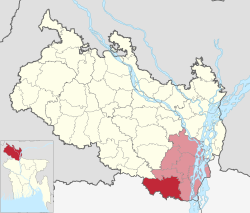Gobindaganj Upazila
Fazle Rabbi Sohan
This article needs additional citations for verification. (April 2013) |
Gobindaganj Upazila
গোবিন্দগঞ্জ উপজেলা | |
|---|---|
 Birat Rajar Mound | |
 | |
| Coordinates: 25°8′N 89°23.5′E / 25.133°N 89.3917°E | |
| Country | |
| Division | Rangpur |
| District | Gaibandha |
| Area | |
| • Total | 460.42 km2 (177.77 sq mi) |
| Population (2011) | |
| • Total | 514,696 |
| • Density | 1,100/km2 (2,900/sq mi) |
| Time zone | UTC+6 (BST) |
| Postal code | 5740 & 5741(Mahimaganj). |
| Website | gobindaganj |
Gobindaganj (Bengali: গোবিন্দগঞ্জ) is an Upazila of Gaibandha District and the Division of Rangpur.[1] It is one of the largest upazila in Bangladesh including 17 unions and 1 municipality.
Geography[edit]
Gobindaganj is located at 25°08′00″N 89°23′30″E / 25.1333°N 89.3917°E. It has 132,572 households and total area 460.42 km2.
Demographics[edit]
According to the 2011 Bangladesh census, Gobindaganj Upazila had 132,572 households and a population of 514,696. 119,767 (23.27%) were under 10 years of age. Gobindaganj had a literacy rate (age 7 and over) of 42.59%, compared to the national average of 51.8%, and a sex ratio of 1013 females per 1000 males. 38,415 (7.46%) lived in urban areas.[2] Ethnic population was 3,351 (0.65%), of which Santal were 3,086.[3]
As of the 1991 Bangladesh census, Gobindaganj has a population of 414591. Males constitute are 50.89% of the population, and females 49.11%. This Upazila's eighteen up population is 205,204. Gobindaganj has an average literacy rate of 23.1% (7+ years), and the national average of 32.4% literate.[4]
Administration[edit]
Gobindaganj Upazila is divided into Gobindaganj Municipality and 17 union parishads: Kamdia, Katabari, Shakhahar, Razahar, Sapmara, Darbosta, Taluk Kanupur, Nakai, Harirampur, Rakhalbururz, Fulbari, Gumanigonj, Kamardaha, Kocha Shahar, Shibpur, Mahimaganj, Shalmara. The union parishads are subdivided into 339 mauzas and 375 villages.[2]
Gobindaganj Municipality is subdivided into 9 wards and 22 mahallas.[2]
In terms of total area and number of unions, it is the second largest upazila in Bangladesh. It is called the nucleus of Rangpur Division. It has 13 branches of different banks and 11 colleges as well.
Politicians[edit]
Former Mayor :Ataur Rahman Sarker
Current Mayor : Rafi
MP : Kalam
Economy[edit]
1. Small Cottage Industries (Kocha Shahar).
2. Rangpur Sugar Mills Limited (Mahimaganj).
3. Agriculture (Rice & paddy, sugarcane, fisheries, and cattle rearing)
4. Business and others. 5. 001
Fazle Rabbi Sohan
Education[edit]
According to Banglapedia, Gobindagonj Multilateral High School, founded in 1912, is a notable secondary school.[1]
Literacy rate and educational institutions Average literacy 37.8%; male 42.9%, female 32.5%. Educational institutions: college 13, technical college 1, law college 1, teachers training college 1, secondary school 72, primary school 239, madrasa 153. Noted educational institutions: Gobindaganj Degree College (1965), Kamdia Nurul Haque Degree College (1972), Mahimaganj Degree College (1972), Gobindaganj Mahila College (1991), Nakaihat College, Mahimaganj Women College, Phulpukuria College, Shamim & Shakil Technical College, Akramul Haque Computer and ideal College, Shohorgachhi Adarsa Degree College, Gobindaganj Multilateral High School (1912), Kamdia Bilateral High School (1921), Gobindaganj BM Girls' High School (1940), Rangpur Sugar Mills High School (1962), Birat High School (1964), Shahargachhi Girls' High School (1971), Mahimaganj Alia Madrasa (1937), Mahimagonj high School(1945),Chandpara Alim Madrasa (1963), Chandpara Bi-Lateral High School (1965), Kocha Shahar Bi-Lateral High School (1962), Kocha Shahar Shilpanagori College o Goveshona Kendra (2002).
References[edit]
- ^ a b Nandi, Bishnu (2012). "Gobindaganj Upazila". In Islam, Sirajul; Jamal, Ahmed A. (eds.). Banglapedia: National Encyclopedia of Bangladesh (Second ed.). Asiatic Society of Bangladesh.
- ^ a b c d "Bangladesh Population and Housing Census 2011 Zila Report – Gaibandha" (PDF). bbs.gov.bd. Bangladesh Bureau of Statistics.
- ^ "Community Tables: Gaibandha district" (PDF). bbs.gov.bd. Bangladesh Bureau of Statistics. 2011.
- ^ "Population Census Wing, BBS". Archived from the original on 2005-03-27. Retrieved November 10, 2006.

